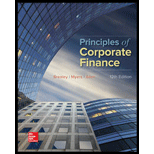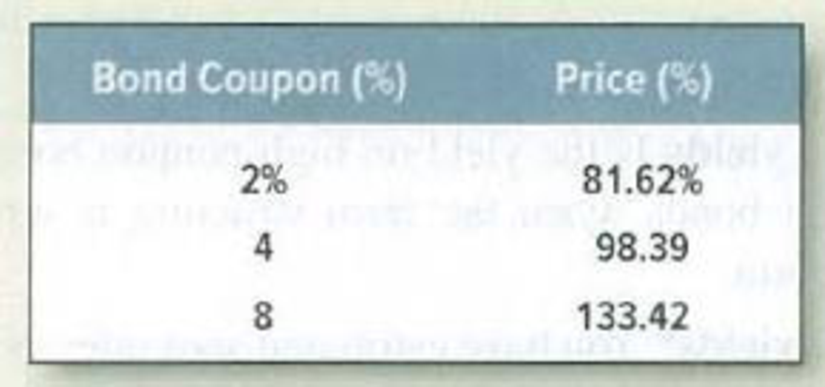
Principles of Corporate Finance (Mcgraw-hill/Irwin Series in Finance, Insurance, and Real Estate)
12th Edition
ISBN: 9781259144387
Author: Richard A Brealey, Stewart C Myers, Franklin Allen
Publisher: McGraw-Hill Education
expand_more
expand_more
format_list_bulleted
Textbook Question
Chapter 3, Problem 15PS
Duration Here are the prices of three bonds with 10-year maturities:

If coupons are paid annually, which bond offered the highest yield to maturity? Which had the lowest? Which bonds had the longest and shortest durations?
Expert Solution & Answer
Want to see the full answer?
Check out a sample textbook solution
Students have asked these similar questions
Your father is 50 years old and will retire in 10 years. He expects to live for 25 years after he retires, until he is 85. He wants a fixed retirement income that has the same purchasing power at the time he retires as $45,000 has today. (The real value of his retirement income will decline annually after he retires.) His retirement income will begin the day he retires, 10 years from today, at which time he will receive 24 additional annual payments. Annual inflation is expected to be 5%. He currently has $180,000 saved, and he expects to earn 8% annually on his savings. The data has been collected in the Microsoft Excel Online file below. Open the spreadsheet and perform the required analysis to answer the question below.
Required annuity payments
Retirement income today
$45,000
Years to retirement
10
Years of retirement
25
Inflation rate
5.00%
Savings
$180,000
Rate of return
8.00%
A textile company produces shirts and pants. Each shirt requires three square yards of cloth, and each pair of pants requires two square yards of cloth. During the next two months the following demands for shirts and pants must be met (on time): month 1, 2,000 shirts and 1,500 pairs of pants; month 2, 1,200 shirts and 1,400 pairs of pants. During each month the following resources are available: month 1, 9,000 square yards of cloth; month 2, 6,000 square yards of cloth. In addition, cloth that is available during month 1 and is not used can be used during month 2. During each month it costs $10 to produce an article of clothing with regular time labor and $16 with overtime labor. During each month a total of at most 2,000 articles of clothing can be produced with regular time labor, and an unlimited number of articles of clothing can be produced with overtime labor. At the end of each month, a holding cost of $1 per article of clothing is incurred (There is no holding cost for cloth.)…
What is the general problem statement of the leaders lack an understanding and how to address job demands, resulting in an increase in voluntary termination?
Refer to the article of Bank leaders discovered from customer surveys that customers are closing accounts because their rates are not competitive with area credit unions. Job demands such as a heavy workload interfered with employee performance, leading to decreased job performance.
Chapter 3 Solutions
Principles of Corporate Finance (Mcgraw-hill/Irwin Series in Finance, Insurance, and Real Estate)
Ch. 3 - (PRICE) In February 2009, Treasury 8.5s of 2020...Ch. 3 - (YLD) On the same day, Treasury 3.5s of 2018 were...Ch. 3 - (DURATION) What was the duration of the Treasury...Ch. 3 - (MDURATION) What was the modified duration of the...Ch. 3 - Prob. 1PSCh. 3 - Bond prices and yields The following statements...Ch. 3 - Prob. 3PSCh. 3 - Bond prices and yields A 10-year German government...Ch. 3 - Bond prices and yields Construct some simple...Ch. 3 - Spot interest rates and yields Which comes first...
Ch. 3 - Prob. 7PSCh. 3 - Spot interest rates and yields Assume annual...Ch. 3 - Prob. 9PSCh. 3 - Prob. 10PSCh. 3 - Duration True or false? Explain. a....Ch. 3 - Duration Calculate the durations and volatilities...Ch. 3 - Term-structure theories The one-year spot interest...Ch. 3 - Real interest rates The two-year interest rate is...Ch. 3 - Duration Here are the prices of three bonds with...Ch. 3 - Prob. 16PSCh. 3 - Prob. 17PSCh. 3 - Spot interest rates and yields A 6% six-year bond...Ch. 3 - Spot interest rates and yields Is the yield on...Ch. 3 - Prob. 20PSCh. 3 - Prob. 21PSCh. 3 - Duration Find the spreadsheet for Table 3.4 in...Ch. 3 - Prob. 23PSCh. 3 - Prob. 25PSCh. 3 - Prob. 26PSCh. 3 - Prob. 27PSCh. 3 - Prob. 28PSCh. 3 - Prob. 29PSCh. 3 - Prices and yields If a bonds yield to maturity...Ch. 3 - Prob. 31PSCh. 3 - Price and spot interest rates Find the arbitrage...Ch. 3 - Prob. 33PSCh. 3 - Prices and spot interest rates What spot interest...Ch. 3 - Prices and spot interest rates Look one more time...
Knowledge Booster
Learn more about
Need a deep-dive on the concept behind this application? Look no further. Learn more about this topic, finance and related others by exploring similar questions and additional content below.Similar questions
- Don't used hand raitingarrow_forward1 2 Fast Clipboard F17 DITECTIONS. BIU- Font B X C A. fx =C17+D17-E17 E F Merge & Center - 4 $ - % 9 4.0.00 Conditional Format as .00 9.0 Alignment Number Cell Formatting - Table - Table Styles - Styles Insert Delete Fe Cells H Mario Armando Perez is the kitchen manager at the Asahi Sushi House. Mario's restaurant offers five popular types of sushi roll. Mario keeps 4 careful records of the number of each roll type sold, from which he computes each item's popularity index. For March 1, Mario estimates 150 5 guests will be served. 6 8 9 10 11 04 At the end of the day, Mario also records his actual number sold in order to calculate his carryover amount for the next day. 7 Based on his experience, and to ensure he does not run out of any item, Mario would like to have extra servings (planned overage) of selected menu items available for sale. Using planned overage, the popularity index of his menu items, and his prior day's carryover information, help Mario determine the amount of new…arrow_forwardYour company is planning to borrow $2.75 million on a 5-year, 16%, annual payment, fully amortized term loan. The data has been collected in the Microsoft Excel Online file below. Open the spreadsheet and perform the required analysis to answer the question below. Amortization Loan amount $2,750,000 Term in years 5 Annual coupon rate 16.00% Calculation of Loan Payment Formula Loan payment = #N/A Loan Amortization Schedule Year Beginning Balance Payment Interest Principal Ending Balance 1 2 3 4 5 Formulas Loan Amortization Schedule Year Beginning Balance Payment Interest Principal Ending Balance 1 #N/A #N/A #N/A #N/A #N/A 2 #N/A #N/A #N/A #N/A #N/A 3 #N/A…arrow_forward
- Your father is 50 years old and will retire in 10 years. He expects to live for 25 years after he retires, until he is 85. He wants a fixed retirement income that has the same purchasing power at the time he retires as $45,000 has today. (The real value of his retirement income will decline annually after he retires.) His retirement income will begin the day he retires, 10 years from today, at which time he will receive 24 additional annual payments. Annual inflation is expected to be 5%. He currently has $180,000 saved, and he expects to earn 8% annually on his savings. The data has been collected in the Microsoft Excel Online file below. Open the spreadsheet and perform the required analysis to answer the question below. Required annuity payments Retirement income today $45,000 Years to retirement 10 Years of retirement 25 Inflation rate 5.00%…arrow_forwardDon't used hand raitingarrow_forwardI need help on the last part of the question that was marked incorrect. Thanksarrow_forward
- Don't used hand raitingarrow_forwardAnswer in step by step with explanation. Don't use Ai and chatgpt.arrow_forwardArticle: Current Bank Problem Statement The general problem to be surveyed is that leaders lack an understanding of how to address job demands, resulting in an increase in voluntary termination, counterproductive workplace outcomes, and a loss of customers. Bank leaders discovered from customer surveys that customers are closing accounts because their rates are not competitive with area credit unions. Job demands such as a heavy workload interfered with employee performance, leading to decreased job performance. Healthcare employees who felt the organization’s benefits were not competitive were more likely to quit without notice, resulting in retention issues for the organization. Information technology leaders who provide job resources to offset job demand have seen an increase in (a) new accounts, (b) employee productivity, (c) positive workplace culture, and (d) employee retention. The specific problem to be addressed is that IT technology leaders in the information technology…arrow_forward
- How to rewrite the problem statement, correcting the identified errors of the Business Problem Information and the current Bank Problem Statement (for the discussion: Evaluating a Problem Statement)arrow_forwardDon't used hand raiting and don't used Ai solutionarrow_forward3 years ago, you invested $9,200. In 3 years, you expect to have $14,167. If you expect to earn the same annual return after 3 years from today as the annual return implied from the past and expected values given in the problem, then in how many years from today do you expect to have $28,798?arrow_forward
arrow_back_ios
SEE MORE QUESTIONS
arrow_forward_ios
Recommended textbooks for you
 Intermediate Financial Management (MindTap Course...FinanceISBN:9781337395083Author:Eugene F. Brigham, Phillip R. DavesPublisher:Cengage LearningPrinciples of Accounting Volume 1AccountingISBN:9781947172685Author:OpenStaxPublisher:OpenStax College
Intermediate Financial Management (MindTap Course...FinanceISBN:9781337395083Author:Eugene F. Brigham, Phillip R. DavesPublisher:Cengage LearningPrinciples of Accounting Volume 1AccountingISBN:9781947172685Author:OpenStaxPublisher:OpenStax College

Intermediate Financial Management (MindTap Course...
Finance
ISBN:9781337395083
Author:Eugene F. Brigham, Phillip R. Daves
Publisher:Cengage Learning

Principles of Accounting Volume 1
Accounting
ISBN:9781947172685
Author:OpenStax
Publisher:OpenStax College
Journalizing Bonds Payable/Amortization of a Premium; Author: TLC Tutoring;https://www.youtube.com/watch?v=5gEpAFFnIE8;License: Standard YouTube License, CC-BY
Investing Basics: Bonds; Author: TD Ameritrade;https://www.youtube.com/watch?v=IuyejHOGCro;License: Standard YouTube License, CC-BY